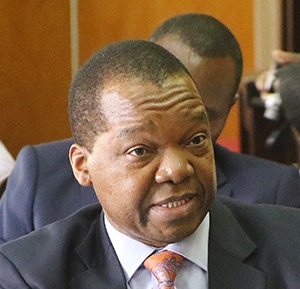John Mangudya, head of Reserve Bank of Zimbabwe, describes his efforts to move the bank away from the quasi-fiscal activities that distracted it from its core mission.

Global Finance: How have global financial developments impacted Zimbabwe’s financial sector?
John Mangudya: The country’s financial sector is integrated with the global financial system, including through the network of foreign owned financial institutions operating in Zimbabwe, including Standard Chartered, Standard Bank, Nedbank and CABS, controlled by Old Mutual. The country is, therefore, not immune to the spillover effects of financial system fragilities in the developed world. On the upside, the existence of correspondent banking relationships with foreign-owned banks continues to ease access to foreign loans, lines of credit and foreign capital. Some developments in developed nations could result in short-term capital flowing into developing countries such as Zimbabwe as investors seek higher returns.
GF: What is unique about central banking in the Zimbabwean context? What are the major challenges in maintaining stability in the banking sector?
Mangudya: Central banking in Zimbabwe was unique under the multicurrency system adopted by the government in 2009. The multicurrency system reduced the scope of the central bank’s autonomy, as the bank couldn’t use interest rates or exchange rate to stimulate economic activity under a hard peg to the US dollar. The introduction of the local currency in June 2019 has restored that monetary policy toolkit. The bank is now in a position to use conventional monetary policy tools and structural policies to ensure price stability, smoothen business-cycle fluctuations and complement fiscal policy in stimulating economic growth and development.
GF: The central bank of Zimbabwe got distracted by dabbling in quasi-fiscal activities, such as foreign currency allocations and agricultural financing. What have you done to refocus the bank on its key roles?
Mangudya: Significant strides have been made in terms of reverting the Reserve Bank of Zimbabwe back to its core business of central banking. The country has successfully de-dollarized and is now using its own currency. This was followed by the liberalization of the exchange rate through the establishment of an interbank foreign exchange market on February 20 of this year, and eventually the removal of the multicurrency system and reintroduction of the local currency June 24. Importantly, the adoption of a flexible exchange rate will assist greatly in absorbing shocks, thereby giving effectiveness to monetary policy independence in a more open environment.
GF: What is the monetary situation in Zimbabwe? How is the central bank addressing distortions, money-supply issues and exchange rate developments?
Mangudya: The bank has adopted a monetary targeting framework, with the base money as an operational target of monetary policy. Under this framework, the bank targets reserve money growth of between 9% and 10%. Using internal models, the bank established that there is a one-to-one relationship between inflation and money supply growth, with money supply affecting inflation with a lag of between 6 to 18 months. In this regard, the bank expects that the limited growth in base money will eventually pin down inflation—particularly after the dissipation of the lagging effects of past high money-supply growth, and as adverse inflation expectations are dampened by improved confidence. Our estimates, based on the actual and underlying current account of the balance of payments, suggest that we have gravitated toward exchange rate stability.



